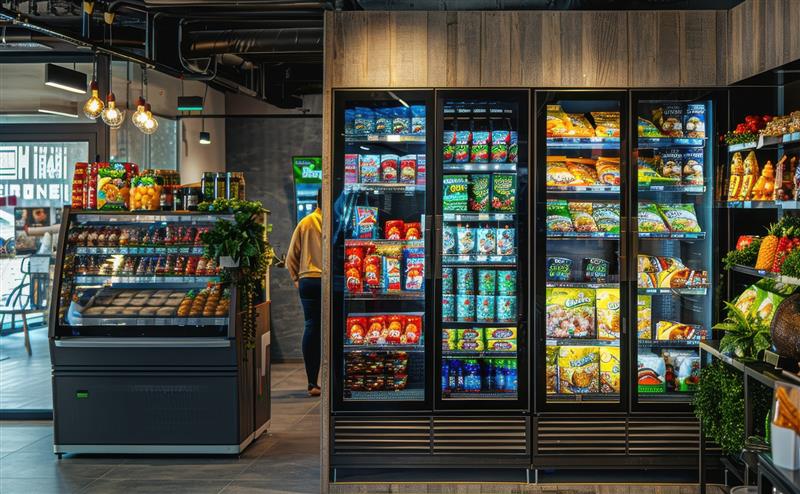In this early summer edition of Talking Points, we source insights from talented RaboResearch colleagues, covering topics from cardboard and currencies to beef and beverages. Though our reports span the entire food system, a focus on the US consumer threads them together.
1. What a difference a hundred days make
A common theme last year was the incredible resilience of the US consumer to keep the economy afloat. Although consumers have developed resilience over the past five turbulent years, current uncertainties due to tariffs, inflation, and potential recession are pushing them to their limits. This
is the topic of a recent report by my colleagues. One hundred days into Trump’s second term, the US is embracing an “America First” strategy that uses tariffs as a foreign policy tool. For US consumers, the concern is that their economic situation may worsen before improving. These sweeping policy shifts are escalating trade disputes that could soon translate into higher prices for food and a heightened risk of recession. My colleagues’ message on the latter could not be blunter, “We now think that the probability of a recession is larger than 50%.” Of course, predictions of a recession were made last year and failed to materialize, so the US consumer could prove everyone wrong again in 2025.
2. The Anti-Obesity Medication (AOM) makeover
Regular readers will know we have been covering the explosion in the market for AOMs and its impact on the diets of patients using these drugs. Two of my colleagues have examined the implications of this development on their respective industries. Let’s start with Jim Owen, whose report’s title says it all, “Appetite for change: Anti-obesity medications could reshape the food packaging industry.” The report explains that these medications encourage a move away from processed, calorie-dense foods toward more nutrient-rich and healthful choices. As a result, packaging manufacturers are experiencing a decrease in traditional packaging volumes while seeing new opportunities in fresh, functional, and premium segments. In the report, Jim argues this evolution will likely prompt US manufacturers and packaging providers to rethink their materials and strategies. They could implement more sustainable, convenient, and adaptable packaging formats that resonate with health-conscious consumers. Interestingly, overall packaging volumes may decline as total food consumption decreases, but a shift toward smaller portion sizes and single-serve formats could offset this. Covering the dairy sector, Lucas Fuess, discusses how steadily growing cheese capacity (to meet American’s insatiable demand for cheese) has resulted in more liquid whey, a byproduct of cheese making that manufacturers can process into high-protein whey products like whey protein isolate. Demand for high-protein whey has been voracious for the last few years as a broader section of the population is adopting fitness routines and seeking protein to support them. More recently, the growing use of GLP-1 agonists is also driving protein consumption, with muscle maintenance as an important factor to consider while utilizing the drugs. Though GLP-1 use may affect cheese demand negatively, we expect it to support whey powder demand.
3. High-protein diets under pressure from sizzling costs
We’ve frequently discussed consumers’ strong interest in protein over the past year. It is fascinating to see how this demand runs into challenges such as the supply constraints faced by several of the animal protein markets. For beef, my colleague Lance Zimmerman sums it up as “Sizzling beef prices ahead of the grilling season.” There are several reasons why consumers are paying more for beef in 2025. This includes years of herd liquidation, compounded by trade disruptions and extreme weather events, leading to a reduced cattle supply. With fewer animals available for slaughter, retail beef prices are set to increase, putting additional strain on household budgets just as consumers are more determined than ever to incorporate quality protein into their diets. To date, consumer demand for beef has remained surprisingly resilient. Beef demand was up 5% last year despite the restaurant sector struggling with declining customer traffic.
Meanwhile, chicken—historically the more affordable protein alternative—is also feeling the pressure. A surge in seasonal demand and foodservice promotions, supported by record-high beef prices, have pushed chicken prices beyond last year’s levels. For example, foodservice demand for breast meat and tenders has strengthened prices compared to last year, with increases of 32% and 12%, respectively. Eggs, another popular protein staple, are not exempt from these trends. According to the Federal Reserve, average monthly retail prices of large Grade A eggs were about USD 1.50 per dozen in Jan 2020 and were almost USD 6.25 per dozen in March of this year. As my colleagues explain, the current spike is down to avian flu with more than 36 million birds already culled this year in the US alone.
So what does all this mean for the consumer? Their ability to prioritize high-protein diets will be increasingly challenged by the combined pressures of constrained beef supplies, rising chicken prices, and record egg costs.
4. A single-serve future
Jim Watson, who introduced me to the AeroPress and to whom I owe eternal gratitude, recently published a note that explains how consumers shifting to single-serve capsules are accelerating the long-term decline of the US roast and ground coffee segment. Nevertheless, Jim argues that while traditional brewed coffee is steadily losing ground to the convenience of single-serve capsules, companies in the roast and ground coffee segment still possess untapped value that may create a more premium and differentiated offering in the future. For example, roasters can refocus on building and promoting their premium brands that connect with younger, affluent coffee drinkers. Companies can also invest in product innovation by updating the packaging, adjusting caffeine levels, and offering single-origin options to refresh their legacy offerings. They can also target modern brands through acquisitions, expanding their appeal beyond the traditional coffee segment. These proactive moves enable roasters to unlock latent value and capture new growth opportunities.
5. Food in flux
Let’s wrap up with some brief highlights from other great reports:
Paper over plastic. In a review of last year’s Pack Expo, Xinnan Li revealed how paper-based packaging is making significant progress as a cost-neutral and sustainable alternative to plastic.This is particularly important for North American consumer brands, which currently experience less regulatory pressure than their European counterparts. There is also a growing segment of US consumers that prefers eco-friendly materials. These shifts mean that the packaging on everyday items—from food and beverages to online purchases—is likely to become increasingly ecofriendly and innovative, reducing reliance on traditional plastics.
Inflation on tap. The RaboResearch beverage team highlights that although US inflation has moderated and wages are beginning to catch up, the cumulative effects of past inflation continue to press on US consumer spending on beverages. This is likely to translate into subdued alcohol sales in the US, as consumers tighten their budgets and seek out value-driven options.
Going bananas. It is not just tariffs that are potentially raising the prices of American staples. According to my colleague, Camila Bonilla-Cedrez, climate change could threaten the supply of America’s favorite fruit. The report warns that climate change—through increased extreme weather, shifting rainfall, and rising disease pressures—is jeopardizing banana yields in key Latin American countries. For the average American consumer, this report signals potential disruptions in the banana supply that could lead to higher prices and less consistent availability at grocery stores. Rectifying this will require increasing the resilience of the supply chain, such as investing in new varieties and reducing the monocropping of banana growing. As Camila concludes, “all of these strategies come at a cost, but so does doing nothing.”
Australia’s recipe for food resilience. Michael Harvey’s report, “Australia’s food market is embracing the new normal,” also highlights the impact of climate change. The report looks back at the impact of “five tumultuous years” on the Australian food ecosystem and how the situation now appears to be settling down to a “new normal.” This new normal entails the transformation of retail and foodservice channels, investment in supply chain resilience, and the repositioning of private labels and sustainability strategies. Although the report concerns Australia, there are useful insights and lessons learned for the US market. Australian food retailers, for example, have had to invest further upstream to address climate and supply chain vulnerabilities in their business. The report is also a useful reminder that consumers have experienced “sticker shock” inflation, hits to consumer confidence, and “endured an extended slump in financial fortunes” in other part of the world. US consumers aren’t the only ones who have been through a lot.
Our take on tariffs. Finally, let’s acknowledge all the work my colleagues have done to analyze the impact of tariffs. Understanding the impact of the tariffs that Trump started to roll out in February (which he has since rolled back, postponed, and triggered counter-tariffs to), has kept many of my colleagues busy.
- Tom Booijink and Mary Ledman of our Dairy Team analyzed “The effects of Trump’s tariff troubles on EU cheese and butter” and concluded that, while the 10% baseline tariff could reduce US imports of EU cheeses by 10% to 15%, American consumers will likely see little impact because increased domestic production and lower exports will offset the decline.
- My fresh produce colleagues, David Magaña and Gonzalo Salinas, have been particularly active on this topic across their sectors. From fresh fruits to tree nuts, all fresh produce sectors share a similar conclusion: Higher prices at retail and greater price volatility as the US adjusts its trade policies amid geopolitical tensions. This is especially likely for tropical fruits, where US domestic production is limited and reliance on imports is high.
- Dirk Jan Kennes and his team studied the US-China tariffs’ effect on China’s food economy and concluded that the impact would be minimal. For example, international players like Mars and Mondelez in the domestic snack market will remain largely unaffected because over 90% of their supply chains are already localized. The tariffs may even increase localization further.
Disclaimer
This document is meant exclusively for you and does not carry any right of publication or disclosure other than to Coöperatieve Rabobank U.A. (“Rabobank”), registered in Amsterdam. Neither this document nor any of its contents may be distributed, reproduced, or used for any other purpose without the prior written consent of
Rabobank. The information in this document reflects prevailing market conditions and our judgement as of this date, all of which may be subject to change. This document is based on public information. The information and opinions contained in this document have been compiled or derived from sources believed to be reliable;
however, Rabobank does not guarantee the correctness or completeness of this document, and does not accept any liability in this respect. The information and opinions contained in this document are indicative and for discussion purposes only. No rights may be derived from any potential offers, transactions, commercial ideas, et
cetera contained in this document. This document does not constitute an offer, invitation, or recommendation. This document shall not form the basis of, or cannot be relied upon in connection with, any contract or commitment whatsoever. The information in this document is not intended, and may not be understood, as an
advice (including, without limitation, an advice within the meaning of article 1:1 and article 4:23 of the Dutch Financial Supervision Act). This document is governed by Dutch law. The competent court in Amsterdam, the Netherlands has exclusive jurisdiction to settle any dispute which may arise out of, or in connection with, this
document and/or any discussions or negotiations based on it. This report has been published in line with Rabobank’s long-term commitment to international food and agribusiness. It is one of a series of publications undertaken by the global department of RaboResearch Food & Agribusiness.

